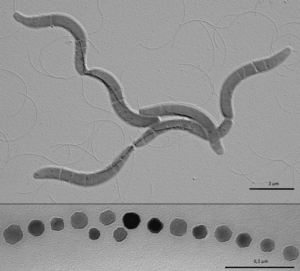Magnetotactic Bacteria: Difference between revisions
No edit summary |
No edit summary |
||
| Line 1: | Line 1: | ||
==Introduction to Magnetotactic Bacteria== | ==Introduction to Magnetotactic Bacteria== | ||
[[Image:magnetotacticmodel.large.jpg|thumb|300px|right| Model | [[Image:magnetotacticmodel.large.jpg|thumb|300px|right| Figure 1- Model of magneto-aeotaxis. Magnetotactic bacteria (black) use the earth's magnetic field (gray lines) as guides to localize to the OATZ while other organisms (white) must rely on other methods for finding the same region. Courtesy of Komeili (http://femsre.oxfordjournals.org/content/36/1/232.figures-only)]] | ||
Magnetotactic bacteria (MB) are bacteria that build specialized organelles called magnetosomes in order to store magnetic material and align themselves with the earth’s magnetic field. Magnetotactic bacteria were first described in 1975 when Richard Blakemore realized that a specific group of bacteria he collected from sediment constantly swam in the same geographic direction, regardless of the positioning of the microscope or external stimuli <sup>[1]</sup>. MB are mostly found in shallow aquatic environments where oxygen and other redox compounds are horizontally stratified and many described magnetotactic bacteria localize at or close to the oxic anoxic transition zone (OATZ)—a region in the water column that has very low oxygen levels <sup>[2]</sup>. The current model to explain the selective advantage provided by magnetosomes is that magnetotactic bacteria are able to locate the OATZ much easier than bacteria that solely use [http://en.wikipedia.org/wiki/Chemotaxis chemotactic] and [http://medical-dictionary.thefreedictionary.com/aerotaxis aerotactic] mechanisms <sup>[3]</sup>. | Magnetotactic bacteria (MB) are bacteria that build specialized organelles called magnetosomes in order to store magnetic material and align themselves with the earth’s magnetic field. Magnetotactic bacteria were first described in 1975 when Richard Blakemore realized that a specific group of bacteria he collected from sediment constantly swam in the same geographic direction, regardless of the positioning of the microscope or external stimuli <sup>[1]</sup>. MB are mostly found in shallow aquatic environments where oxygen and other redox compounds are horizontally stratified and many described magnetotactic bacteria localize at or close to the oxic anoxic transition zone (OATZ)—a region in the water column that has very low oxygen levels <sup>[2]</sup>. The current model (shown in Figure 1) to explain the selective advantage provided by magnetosomes is that magnetotactic bacteria are able to locate the OATZ much easier than bacteria that solely use [http://en.wikipedia.org/wiki/Chemotaxis chemotactic] and [http://medical-dictionary.thefreedictionary.com/aerotaxis aerotactic] mechanisms <sup>[3]</sup>. | ||
Revision as of 03:26, 24 March 2015
Introduction to Magnetotactic Bacteria

Magnetotactic bacteria (MB) are bacteria that build specialized organelles called magnetosomes in order to store magnetic material and align themselves with the earth’s magnetic field. Magnetotactic bacteria were first described in 1975 when Richard Blakemore realized that a specific group of bacteria he collected from sediment constantly swam in the same geographic direction, regardless of the positioning of the microscope or external stimuli [1]. MB are mostly found in shallow aquatic environments where oxygen and other redox compounds are horizontally stratified and many described magnetotactic bacteria localize at or close to the oxic anoxic transition zone (OATZ)—a region in the water column that has very low oxygen levels [2]. The current model (shown in Figure 1) to explain the selective advantage provided by magnetosomes is that magnetotactic bacteria are able to locate the OATZ much easier than bacteria that solely use chemotactic and aerotactic mechanisms [3].
Magnetospirillum gryphiswaldense (also referred to as MSR-1) is a gram negative magnetotactic bacteria that is found in shallow fresh water and sediment. They are characterized by a spirillial morphology with flagella at each end of the cell. They are able to orient themselves based on Earth’s magnetic field (magnetotaxis) due to special organelles called magnetosomes.
Other examples:
Bold
Italic
Subscript: H2O
Superscript: Fe [2]
Magnetosome Formation

Include some current research in each topic, with at least one figure showing data.
Genetic Influences
Include some current research in each topic, with at least one figure showing data.
Potential Uses in Bioremediation
Include some current research in each topic, with at least one figure showing data.
References
[1] Blakemore, R. (1975). Magnetotactic bacteria. Science (New York, N.Y.), 190(4212), 377-379.
Other References:
